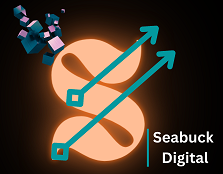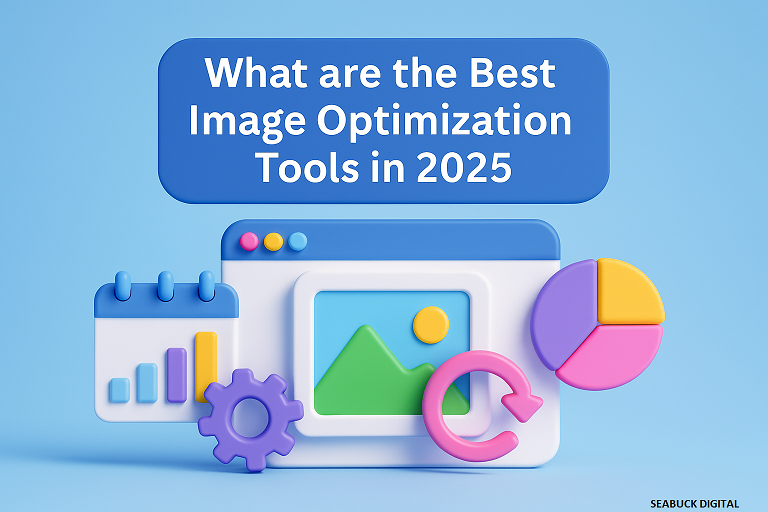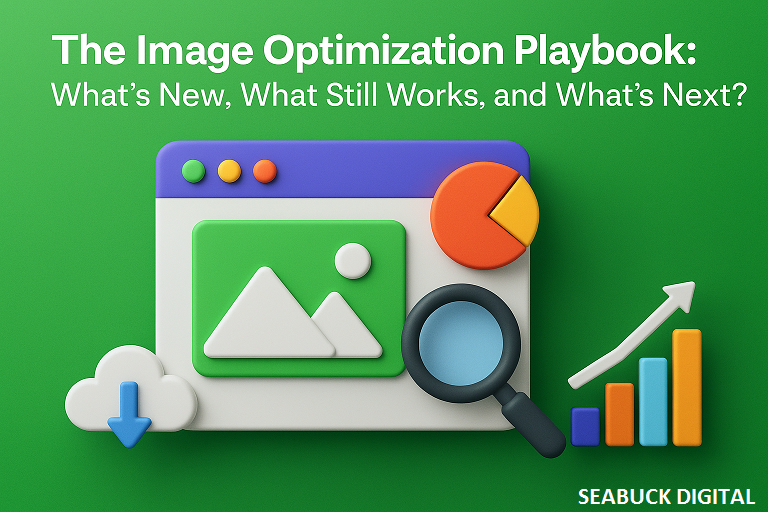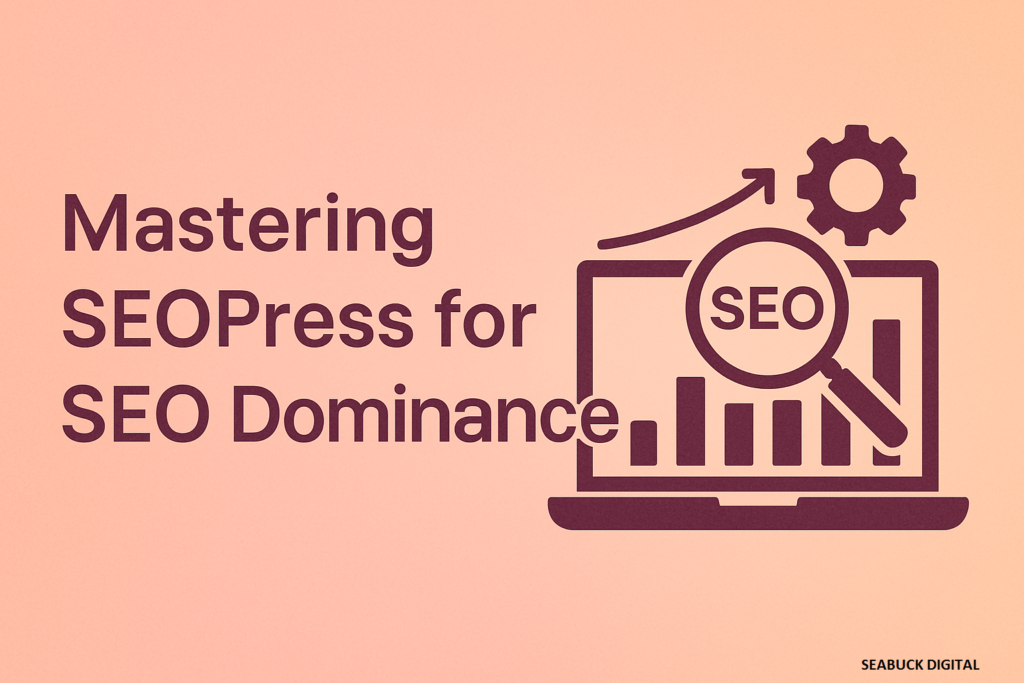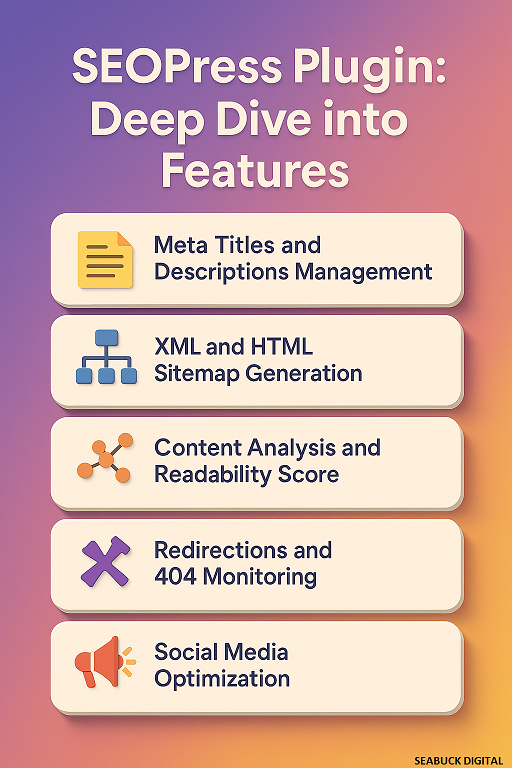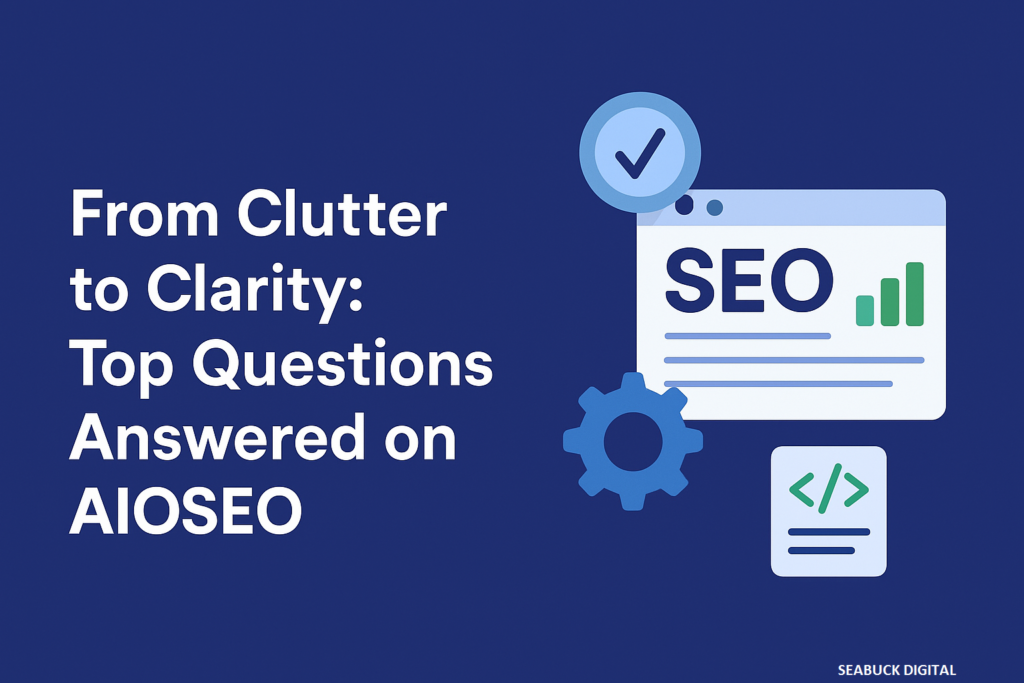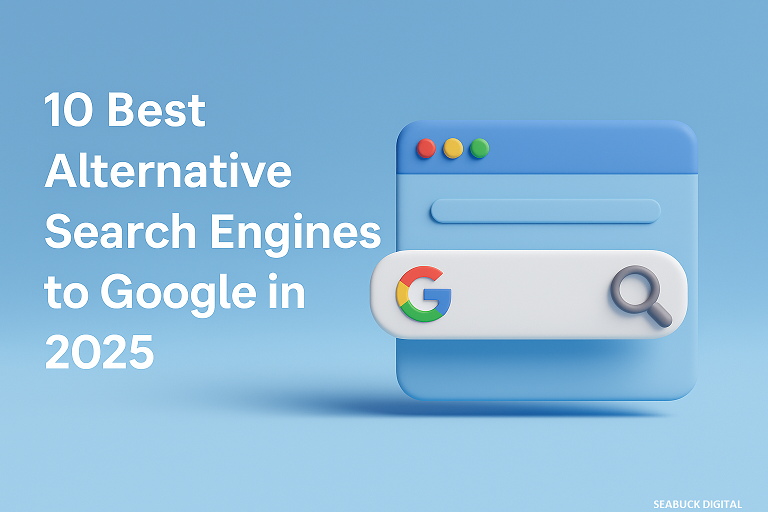
Why Look Beyond Google?
Let’s be honest — Google feels like the only option sometimes. But is it really? Not quite. There’s a whole world of search engines out there just waiting to be explored, and they’re not just clones of Google. They offer privacy, unbiased results, and even eco-friendly missions!
Privacy Concerns with Google
We all know Google loves data like a squirrel loves acorns. Every search you make is stored, analyzed, and used to target you with ads. While that helps Google stay free, it comes at the cost of your privacy.
Monopolization of Search
Google holds over 90% of the global search market. That’s a scary amount of power in one company’s hands. Diversifying where you search can break this monopoly and encourage healthier competition.
The Desire for Diverse Search Experiences
Not every search engine works the same. Some are faster, some are more visual, and some focus purely on ethics. Exploring these alternatives can offer you better, fresher search experiences.
What Makes a Good Alternative Search Engine?
Before you jump ship from Google, let’s get clear on what to look for.
Privacy Protection
If you’re tired of being watched like a hawk, look for engines that promise zero tracking. We’ll cover several below!
Unbiased Results
Google’s algorithm sometimes favors certain viewpoints or commercial interests. Alternatives aim for neutrality.
Regional Relevance
Depending on where you live, some engines provide better localized results — like European-based search engines that follow stricter data protection laws.
Top 10 Best Alternative Search Engines to Google
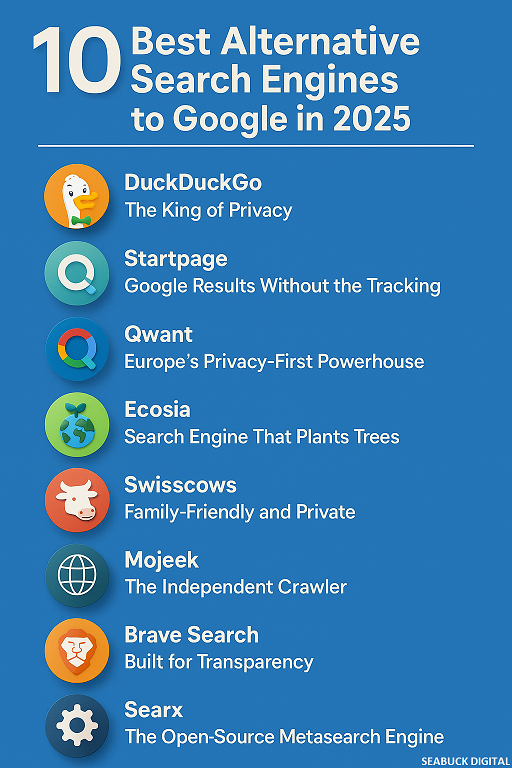
1. DuckDuckGo — The King of Privacy
How DuckDuckGo Protects Your Data
DuckDuckGo is legendary for its privacy stance. No search history, no user profiling, no ads that follow you around the web.
Features That Rival Google
Despite its minimalist vibe, DuckDuckGo packs a punch: instant answers, weather updates, and even !bang commands to search directly on other sites.
2. Startpage — Google Results Without the Tracking
Private Proxy Service
Startpage is genius. It delivers Google search results but strips away all the trackers and ads. It’s like having your cake and eating it too!
European Roots and Data Protection
Based in the Netherlands, Startpage operates under GDPR, giving European users top-tier data privacy.
3. Qwant — Europe’s Privacy-First Powerhouse
GDPR Compliance and European Data Centers
Qwant is a French search engine that prides itself on being a privacy-first option. No tracking cookies, no targeted ads, and totally GDPR-compliant.
Clean and Intuitive Interface
It’s fast, user-friendly, and serves both web and social media results in a neat, organized layout.
4. Ecosia — Search Engine That Plants Trees
How Ecosia Invests in Reforestation
With every search, Ecosia plants trees across the globe. They’ve already planted over 150 million trees!
Ethical and Transparent
Ecosia publishes monthly financial reports, proving they spend about 80% of profits on climate action.
5. Swisscows — Family-Friendly and Private
Semantic Data Recognition
Swisscows doesn’t just fetch keywords; it understands your intent, delivering smarter results.
Switzerland’s Strict Privacy Laws
With servers located in privacy-friendly Switzerland, your searches stay secure and away from prying eyes.
6. Mojeek — The Independent Crawler
No Tracking, No Profiling
Mojeek is one of the few that builds its own search index. Zero tracking, and no user profiles built from your searches.
Truly Unbiased Search Results
Because it doesn’t pull from other search engines, Mojeek offers a refreshingly unbiased perspective.
7. Brave Search — Built for Transparency
Independent Indexing
Brave Search crawls the web independently, reducing reliance on Big Tech search indexes.
Optional Anonymity Mode
With Brave’s optional anonymity mode, you can search without tying queries to your identity.
8. Searx — The Open-Source Metasearch Engine
Aggregates Results from Multiple Sources
Searx doesn’t host its own index. Instead, it pulls results from various sources, giving you a wide view of the web.
Fully Customizable for Privacy Lovers
Being open-source means you can even host your own Searx instance for ultimate privacy control.
9. MetaGer — Germany’s Ethical Search Engine
Non-Profit and Ad-Free Experience
MetaGer operates as a non-profit, meaning it’s free from corporate pressures and ad clutter.
Focus on Privacy and Neutrality
All searches are anonymous, and results are unbiased thanks to its multi-source approach.
10. Yandex — The Russian Giant with Global Reach
Pros and Cons of Using Yandex
Yandex provides a solid alternative with powerful search capabilities, though privacy concerns exist due to Russian jurisdiction.
A Broader Perspective for International Users
Despite concerns, Yandex excels in multilingual searches and local results across Europe and Asia.
A few other Great Search Engines Alternatives to Google
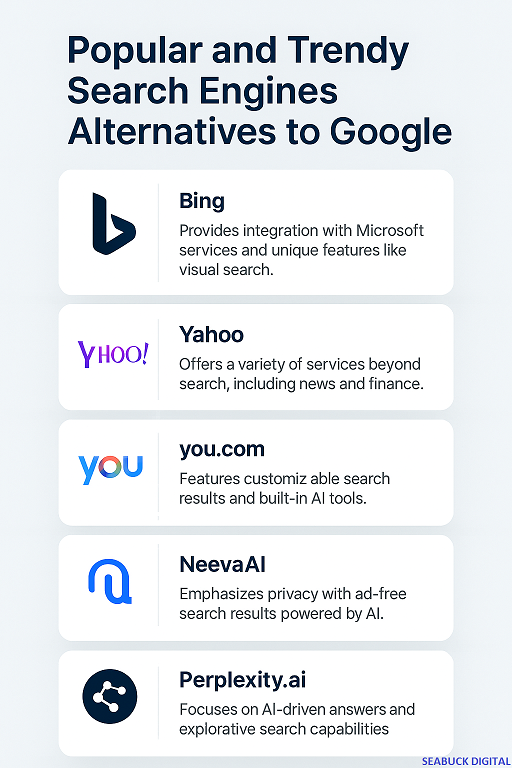
1. Bing
Overview of Bing
Bing, Microsoft’s search engine, has quietly evolved into a powerful contender. It’s sleek, fast, and packed with features that might surprise you.
Why Bing is a Top Google Alternative
Advanced Image Search
Bing’s image search is arguably better than Google’s. It offers crystal-clear thumbnails, filter options, and even an integrated visual search tool.
Integration with Microsoft Ecosystem
If you’re a Windows user, Bing fits like a glove. Cortana, Microsoft Edge, and Office integrations make Bing feel like home.
2. Yahoo Search
Overview of Yahoo Search
Old but gold, Yahoo Search is still relevant and packs a punch.
Comprehensive Search Ecosystem
Rich Media Content
Yahoo’s results often include videos, news, and financial data right at the top.
Integration with Yahoo Services
If you use Yahoo Mail or Yahoo Finance, it all syncs up seamlessly.
3. You.com
Overview of You.com
You.com is like a personalized assistant that doubles as a search engine.
Personalized and Private Search
App-Like Search Experience
It feels like using an app, not just typing in a search box. Very interactive!
Open and Transparent Algorithms
You.com lets you peek under the hood to see how results are generated.
4. NeevaAI
Overview of NeevaAI
Say hello to ad-free searching with a dose of AI brilliance.
Ad-Free, Subscription-Based Search
AI-Enhanced Results
NeevaAI uses advanced AI to surface the most relevant, accurate results without the clutter.
Focus on User Intent
It genuinely tries to understand what you’re looking for, not what advertisers want you to see.
5. Perplexity.ai
Overview of Perplexity.ai
Perplexity.ai is an AI-powered answer engine, not your typical search engine. Instead of just giving you a list of links, it synthesizes answers from multiple sources and presents you with direct, well-cited responses — almost like having an expert researcher at your fingertips.
AI-First, Conversational Approach
Natural Language Answers
What sets Perplexity apart is its ability to respond in a natural, conversational tone. You ask a question, and it replies like a knowledgeable assistant, with clear explanations and follow-up suggestions.
Cited Sources for Transparency
No mystery here — Perplexity always provides its sources, so you can check where the information came from. It even lists multiple perspectives when available.
Why Perplexity.ai is a Game-Changer
Real-Time, Multi-Source Summaries
Perplexity doesn’t just rely on static indexes. It pulls information from across the web in real-time, giving you up-to-date answers from various trusted sources.
Great for Research and Complex Queries
If you’re looking for detailed explanations, comparisons, or summaries of complex topics, Perplexity.ai shines. It’s especially useful for in-depth research or learning something new.
Minimal Ads, Clean Interface
As of now, it’s mostly ad-free and laser-focused on user experience. The interface is clean and easy to navigate, with no clutter.
Which Search Engine is Truly Unbiased?
Understanding Bias in Search Algorithms
No search engine is perfect, but engines like Mojeek and Searx are strong contenders for delivering genuinely unbiased results.
Top Picks for Fair and Balanced Results
For neutrality, consider:
- Mojeek for independent crawling
- Searx for aggregated viewpoints
- MetaGer for multi-source, ad-free results
Conclusion
In 2025, you don’t have to stick with Google. Whether you care about privacy, ethical choices, or just want to try something new, there’s a world of alternatives. DuckDuckGo keeps you private, Ecosia plants trees, and Searx lets you customize your search experience. So go ahead — take control of your online searches. The web is bigger than just one search bar!
FAQs
What is the safest search engine to use in 2025?
DuckDuckGo and Startpage are both excellent for safety, offering strong privacy and data protection.
Are there any good European alternatives to Google?
Absolutely! Qwant, Startpage, and MetaGer are top-notch European choices with strict privacy laws.
Which search engines don’t track users?
DuckDuckGo, Swisscows, and Mojeek all operate with zero tracking policies.
Can alternative search engines show accurate results?
Yes, many like Startpage and Brave Search deliver highly accurate results while respecting your privacy.
What is the best search engine for unbiased results?
Mojeek and MetaGer are excellent picks if you’re looking for unbiased, independent search results.
Read More:
